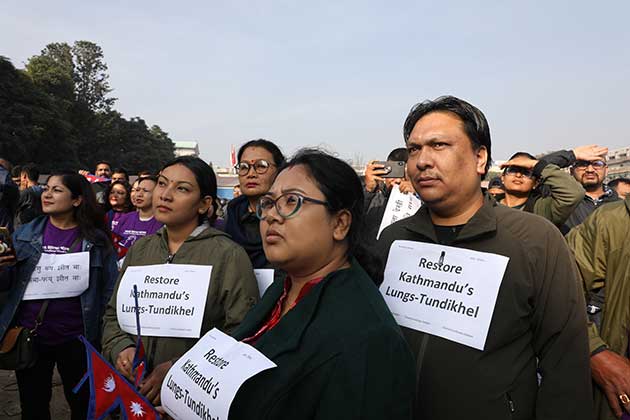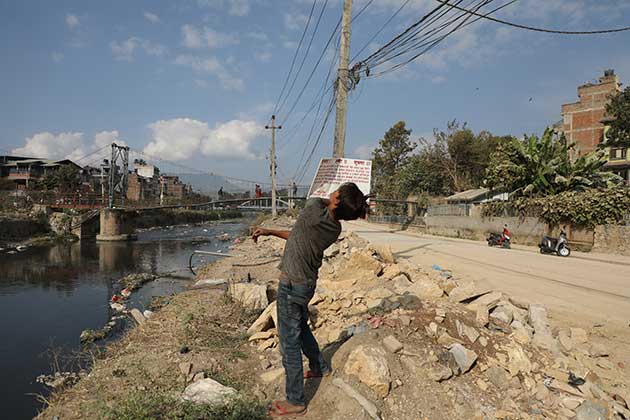From Climate Change to Covid, Are We Ready to Deal with Disasters?

PARIS, Jun 10 (IPS) - In the last 20 years, disasters affected over 4 billion people. At global level we witness on average one sweeping disaster a day, the majority of which are floods and storms. From the Covid-19 pandemic to climate change, calamities are taking new shapes and sizes, infiltrating every dimension of society. From the emotional to the political, how do we deal with disasters? How can we create a whole-of-society approach to disaster risk reduction?
Right through this vortex of intersecting crises, a new toolkit and interactive website by Forus, the Global Network of Civil Society Organizations for Disaster Reduction (GNDR), Save the Children Switzerland and Inventing Futures, with the support of Fondation de France, looks at how civil society organisations coordinate disaster risk reduction and post-emergency interventions. Meant for civil society networks, activists, government officials and community-based organizations, the toolkit provides best-practices from around the globe.
“Today, we are all actors and victims of crises. How can we better understand and learn to cope with them? These practical tools allow us to discover the stakes, the exemplary actions and their effects, through simple definitions and concrete testimonies experienced by civil society,” says Karine Meaux, Emergency manager at Fondation de France.
“Building resilient communities in the face of natural and man-made hazards has never been more important. While disasters don’t discriminate, policies do. Together we can act and put pressure on decision-makers to promote a holistic approach to disaster prevention and reduction and truly people-centred policies,” says Sarah Strack, Director of Forus.
Civil society at the forefront of disaster management
From resilient communities in Nepal, to conflicts in Mali and peace processes in Colombia, the toolkit presents six approaches to disaster risk reduction gleaned from case studies compiled across the civil society ecosystem. The toolkit looks at various topics from capacity building, to local knowledge, resource mobilisation, partnerships with governments and long-term sustainable development and livelihood resilience, ensuring that communities ‘bounce forward’ after a disaster.

Specifically, the toolkit aims to clarify the crucial role frontline civil society organisations play in reducing the impacts of disasters in the midst of an expanding and intensifying global risk landscape. Bridging governments, communities and experts is the only way we can tackle the multiple ways disasters affect local and social processes such as education, migration, food security and peace. If civil society is not free to operate - or even exist - our collective capacity to deal with disasters and create long-term resilience is hampered.
“You have countries in which civil society is not even allowed to exist. This reality changed a lot after the Arab Spring, with countries living in a terrible crisis, with military conflicts, where the role of civil society now is not only to struggle for their existence, but also to provide the population with basic needs and humanitarian interventions,” says Ziad Abdel Samad, Director of the Arab NGO Network for Development (ANND).
Everyday disasters and inequalities
Robert Ninyesiga, from UNNGOF, the national civil society organisation platform in Uganda, argues that in most cases, “more effort has been put towards disaster response while neglecting the disaster prevention aspect”.
This therefore calls for continuous intentional awareness and capacity building as regards to disaster prevention and this can only be effectively achieved if sustainable partnerships between central governments, local governments, civil society organisations, media and citizens are strengthened.
Shock events, high-impact disasters, such as conflicts, earthquakes or tsunamis are just the tip of the iceberg. Underneath this layer there are an increasingly high number of “everyday disasters” affecting people around the globe. Localised, small scale, and slow onset disasters are often “invisible” - far from the spotlight. Those at low incomes are the most vulnerable and find themselves at the periphery of infrastructures, response systems and media attention.
For instance, in addition to being often exposed to intensive disasters such as floods and storms, residents in urban slums across Bangladesh are suffering much more than other communities since the outbreak of the Covid-19 pandemic.

“Most slum dwellers are daily wage earners, but they are not able to earn money. They are not able to maintain social distance, because in one room 4-5 members are living. Many people are using a shared bathroom. It’s very difficult to maintain hygiene. There is not enough space to sit or sleep at home while maintaining sufficient distance. Due to lack of money, many slum dwellers have only one or two meals a day. Violence and sexual harassment are increasing in the community due to cramped conditions. Children are not attending school,” explains the Participatory Development Action Programme (PDAP) which works in the slums of Dhaka .
These pressures add to regular “everyday” challenges of air pollution and garbage management, flooding, water-logged land, and poor quality water.
Local knowledge and Resilient Future
Civil society organisations often fill a tremendous gap and find themselves at the forefront of prevention and emergency efforts. The localisation of responses and partnerships are absolutely crucial to understand the needs of communities in pre and post-disaster scenarios.
In Honduras, civil society has created community-led interventions, to prioritise local plans of action across the country.
“Honduras, and Central America more in general, have been hit in the last 10 years by an intensification of disasters, most of them linked to climate change. Our role in helping communities to adapt to climate change and to deal with disasters, is in terms of capacity building, humanitarian assistance and advocacy by creating links between local, national, regional and global levels,” says Jose Ramon Avila from ASONOG, the national platform of civil society organisations in Honduras.
The intense and cascading nature of risks, such as seen in the cases of Covid-19 and climate change, represent a serious threat to the achievement of a sustainable and resilient future. Growing experience over the last three decades has revealed that disasters and development are closely linked. Ignoring the impact of disasters makes it more difficult to pursue sustainable development.
“Sustainable development can only be achieved when local risk is fully understood. Critical to understanding and assessing the complex threats and risks, challenges and opportunities faced by communities most at risk, is the need to partner with those people. This practical toolkit provides valuable insights and examples from GNDR members and others on how this can be achieved,” says Bijay Kumar, Executive Director, Global Network of Civil Society Organisations for Disaster Reduction (GNDR)
It has also been found that much of the negative impact on sustainable livelihoods comes not from large, ‘intensive’ disasters, but from many smaller, ‘everyday’ disasters. It has become crucial to address intensive and everyday disasters and to integrate our responses with overall work to pursue sustainable development.
We need to ask ourselves this question: can we build new bridges of solidarity between civil society, communities and governments? Can we prevent and anticipate disasters? Our future is not disaster-free; to build resilient communities it is crucial to nurture strong roots for our society to flourish.
The author Bibbi Abruzzini is Communications officer at Forus. Find the toolkit and microsite on Disaster Risk Reduction here. Available in English, French and Spanish.
Follow @IPSNewsUNBureau
Follow IPS New UN Bureau on Instagram
© Inter Press Service (2021) — All Rights Reserved. Original source: Inter Press Service
 Global Issues
Global Issues